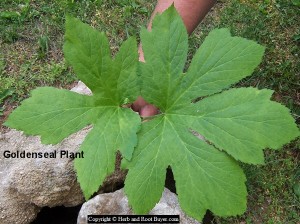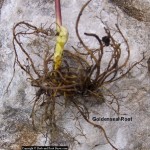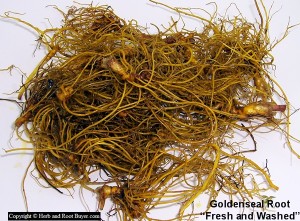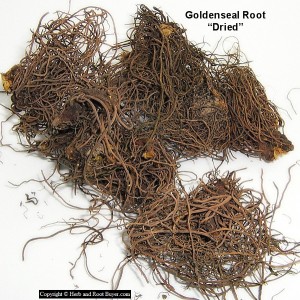Goldenseal – Hydrastis Canadensis
|
Current Demand = Normal |
Parts Used: Herb & Root |
Family: Ranunculaceae Common Names: Yellow Root, Orange Root, Yellow Puccoon, Ground Raspberry, Wild Curcuma, Turmeric Root, Indian Dye, Eye Root, Eye Balm, Indian Paint, Jaundice Root, Warnera….
Description:
Goldenseal is a small perennial herb that has a horizontal, irregularly knotted, bright yellow root-stock, giving off slender roots below and marked with cars of the flower stems of previous years. The leaves and roots resemble the raspberry. The stem reaches 6-12 inches in height, is hairy with downward-pointing hairs. It bears 2 prominently-veined and wrinkled, dark green, hairy leaves, with 5-7 lobes and finely toothed. There is one solitary radical leaf on a long stalk, usually about 9 inches across. The flower is solitary, terminal, erect, small with 3 small greenish-white sepals blooms in April. The fruit follows the flower and is a large, fleshy, berrylike head, which when it ripens in the autumn, is bright red, resembling a large raspberry, and contains from 10-20 small, shining, hard, black seeds. The berry is ripe is July and is not edible.
Growing region: Goldenseal can be found in the Eastern United States and Canada. It is common thru-out the Midwest and Appalachian region west to Arkansas. It is often found in rich moist woods with well drained soil.
Harvesting/Drying:
Parts Used: herb & root
For maximum potency Goldenseal should be harvested in the late summer and fall after the seed has matured. If harvesting the herb, this must be done while the plant still has green color in late summer. Do not harvest leaves or herbs in the rain. Gather the larger more mature plants leaving plenty of younger plants to seed the area for future harvest. Since goldenseal often grows in very large patches, you can often rotate your harvest every three to four years and maintain healthy populations.
It is a little known fact that harvesting mature plants from a healthy goldenseal patch actually promotes future growth as mature roots, ten years and older will begin to die off. By utilizing proper harvesting techniques, the small hair like runners which grow from the main rhizome will often put off multiple new plants as well as most broken roots will produce a new healthy plant. After harvest, the roots should be washed in cold water and foreign material (rocks, dirt and other roots) should be removed. Never soak roots in an attempt to clean them as this will extract vital alkaloids. Separate the stem from the root where the two meet at ground level.
The herb should not need to be washed. Unless your buyer is purchasing fresh dug roots (which they often do and pay more for them) the clean roots need to be dried. Large roots may need to be broken in half to aid in drying. Goldenseal roots can be dried in the sun although if possible dry indoors in a well ventilated barn loft or attic to protect from the elements. If natural heat is not available, you may need to add heat and a fan for continuous airflow. An old screen or wire mesh on a 2×4 frame works well for drying goldenseal. When drying the leaf and herb, you must do so indoors out of the sun to retain the green color.
A mesh bag lightly packed with leaf hung from rafters of a well ventilated attic works great. Some gatherers chose to bunch herbs together and tie the stems for hanging; however, this is not a good drying method. If the bunches are too large the stems usually mold and the inner bunch of leaf will turn black. The key to drying any herb, root or bark is an even combination of heat and airflow. Never dry in an oven or microwave. Once the goldenseal will completely dry (largest root will snap not bend) in about 5-10 days, depending on the size of the root and the drying conditions. The leaf should crumble when dry in 4-8 days again depending on the drying conditions. Place roots separate from the herb carefully into a cardboard box or paper bag for storage in a dry area until ready to sell or use. Do not store the herbs or root in plastic or it will mold.
Planting/Cultivation:
Propagate by rootlets planted in the fall or by division when dormant. Plant in rich moist well-drained soil and plant several together to make a community. Germination from seed is slow and difficult. The plant requires from 60 to 75 per cent shade. The root-stocks are divided into small pieces and then planted about 8 inches apart in rows Seed – sow autumn or early spring in a moist sandy loam in a shady part of the cold frame or greenhouse. The seed is slow to germinate. Prick out the seedlings into individual pots when they are large enough to handle and grow them on in light shade in the greenhouse for the first year or two. Plant out into their permanent positions when the plants are dormant and divide the roots in autumn. The roots can be divided into quite small pieces and can also be transplanted at almost any time of the year. Larger clumps can be replanted direct into their permanent positions, though it is best to pot up smaller clumps and grow them on in a cold frame until they are rooting well. Plant them out in the spring.
 Root Buyer
Root Buyer


